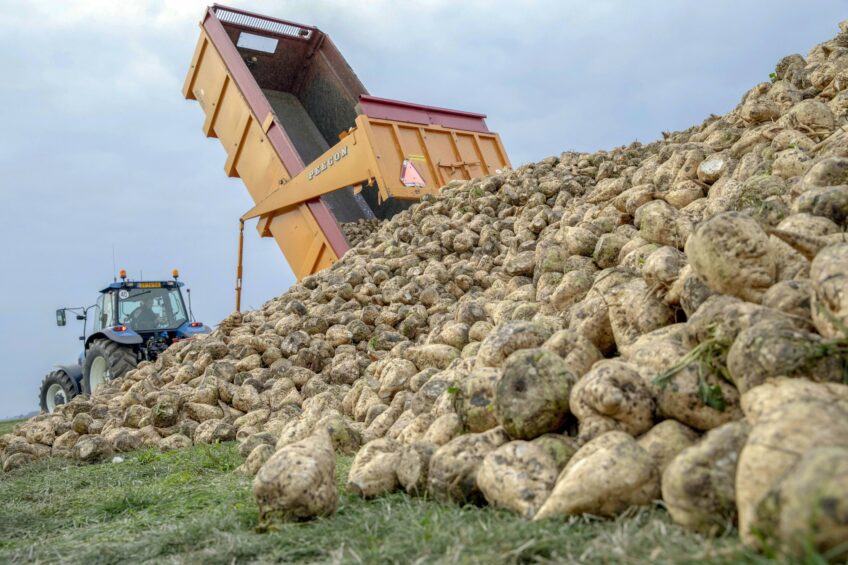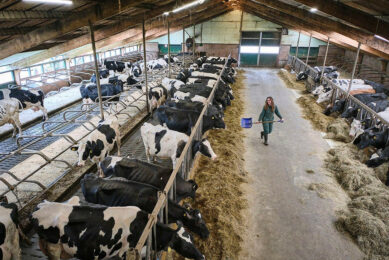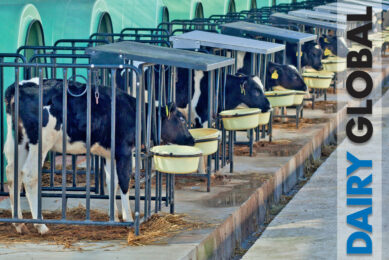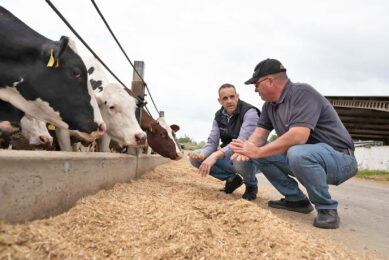4 alternative forage sources for cows

Corn silage and alfalfa are the most common forages fed to dairy cattle. But are there any alternatives? Here we present 4 of them.
 Wheat straw and corn stover
Wheat straw and corn stover
Residues from cereal crops are commonly fed to dairy dry cows and heifers. However, inclusion of these feeds in lactating diets is very limited due to their low-energy and high-fibre content. A recent study from The Ohio State University evaluated whether corn stover and wheat straw can be added to mid-lactating dairy cow diets as a source of physically effective fibre. The researchers (Eastridge et al., 2017) compared total mixed rations (TMR) containing 18.0% forage fibre (NDF) by feeding 34% corn silage in a dry matter (DM) basis plus either 11.5% alfalfa hay, 5.0 % wheat straw or 5.5% corn stover. The results, published in Animal Feed Science and Technology, showed similar performance (36.8 kg/day 3.5% fat-corrected milk, 3.7% milk fat, 2.85% milk protein), rumen pH (6.12), ruminal concentrations of total volatile fatty acids (164 mM), rumen mat consistency, and total tract apparent digestibility among diets. These findings suggest that in corn silage-based diets, corn stover and wheat straw can replace alfalfa hay when included in the diets at low level (5 – 5.5%).

 Sorghum-alfalfa silage
Sorghum-alfalfa silage
A study conducted at the Agricultural Research Station of Tarim University, XinJiang (China) evaluated the optimal combination and the associative effects of ensiling sorghum and alfalfa. The researchers Jiang Zhang et al. (2015) tested 6 different mixtures of sorghum (Sorghum bicolor) and alfalfa harvested at milky stage and at early bloom stage (10% flowering rate), respectively, containing 0%, 20%, 40%, 60%, 80% and 100% sorghum in a fresh matter basis. Dry matter, protein and fibre (aNDFom) contents on fresh alfalfa and sorghum were 38.6 and 28.2%, 22.7 and 7.2%, and 21.5 and 48.1%, respectively. The article, published in the Animal Feed Science and Technology, showed in vitro organic matter degradability decreased linearly with the inclusion of sorghum in the silage mixture: 72.0, 74.9, 67.6, 58.0, 52.2, and 49.8% in a DM basis for combinations containing 0:100, 20:80, 40:60,60:40, 80:20, and 100:0 of sorghum:alfalfa, respectively. The best combination for lactating ruminants was a silage mixture containing 20 – 40% of sorghum.
 Hydroponically grown barley sprouts
Hydroponically grown barley sprouts
Sprouted grain is a method to produce fresh forage for dairy cattle. 5 grains were evaluated for use in a fodder production system at the University of Minnesota West Central Research and Outreach Center, Morris, Minnesota (Soder et al., 2018). The grains (barley, oats, wheat, rye, and triticale) were sprouted for 7 days and tested for nutritional composition (Table 1). Barley had the least DM content (15.5%) of all sprouted grains, whereas triticale had the greatest (24.2%). As expected due to its greater fibre content in the original grain, sprouted oats had the greatest fibre content (neutral and acid detergent fibre).
Researchers from South Dakota State University evaluated the effects on milk performance of feeding cows hydroponically grown barley sprouts. The authors (Lawrence et al.) included 8% (DM basis) of hydroponic barley sprouts in the diet replacing some corn and soybean meal. The results of this study were published at the American Dairy Science Association Annual Meeting, Pittsburg (PA) in 2017. According to this work, barley sprouts can replace partially corn and soybean meal without affecting milk production and ruminal fermentation. The cows showed no difference in DM intake (23.0 kg/d) and body weight (685 kg) between diets. Milk production (30.6, and 31.5 kg/d for control and barley sprouts, respectively) and feed efficiency (1.33 and 1.40) had treatment by week interactions. Milk protein (0.94 kg/d) and milk fat (1.1 kg/d) yields were similar. Moreover, rumen pH (6.57), ammonia-N (13.3 mg/dL), total volatile fatty acids (95.3 mM), and acetate to propionate ratio (3.05) were not significantly different.
 Ensiled sugar beets
Ensiled sugar beets
Sugar beets have been traditionally fed to dairy cattle due to its high energy content. The crop yields approximately 50 tonnes per hectare with an average DM of 23%. Researchers at the Danish Cattle Research Centre evaluated the effect on dairy cow performance when ensiled sugar beets partially replaced corn silage. Beets were cleaned, washed, mashed using a tub grinder, and ensiled in bulk containers. Beet silage dry matter, protein, fibre, and ash contents were 20.4, 5.8, 10.6, and 4.8% as DM basis. During the ensiling process, sugars are fermented to volatile fatty acids and ethanol. Therefore, glucose and sucrose levels in the silage were very low (1.8 and 0.14% DM, respectively) but ethanol content was high (9.1% of DM). The diet without beet silage was composed of grass-clover silage (34% on DM basis), corn silage (28% on DM basis), and a concentrate blend. In the beet silage diet, ²⁄3 of the corn silage was replaced with sugar beet silage on DM basis so corn and beet silage inclusion levels were 9.5 and 16.7% of DM, respectively. The authors (Frydendahl Hellwing et al., 2017) did not find differences in DM intake (23.8 kg/day), energy corrected milk (36.6 kg/day), and feed efficiency (1.54 kg ECM/DMI) between diets. However, cows receiving the beet silage diet produced less milk (35.5 vs. 37.1 kg/day) but the concentrations of fat and protein in milk were higher (4.15 vs. 3.92% and 3.57 vs. 3.50%, respectively). The results show that ensiled sugar beets may be an effective replacement of corn silage mainly in the cheese market areas where milk components are highly valued.
2 nd author of this article is Nuria García, Research Scientist in Food and Animal Sciences in the Animal Disease Research and Diagnostic Laboratory at South Dakota State University.










